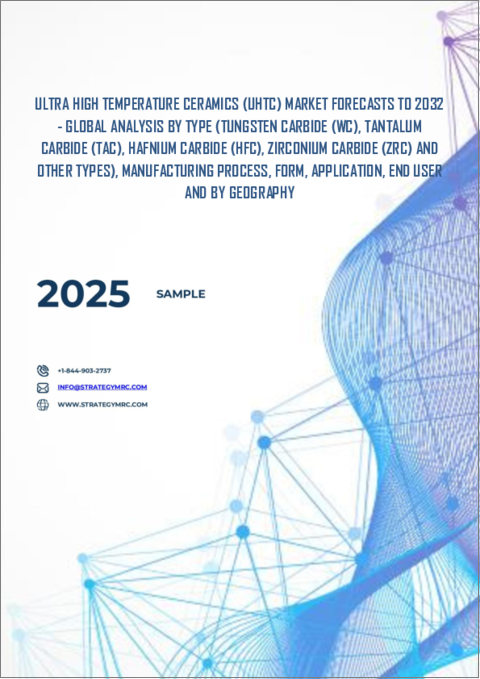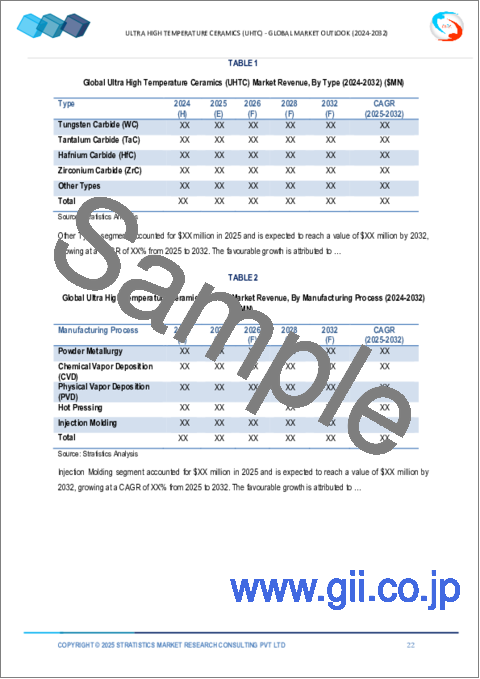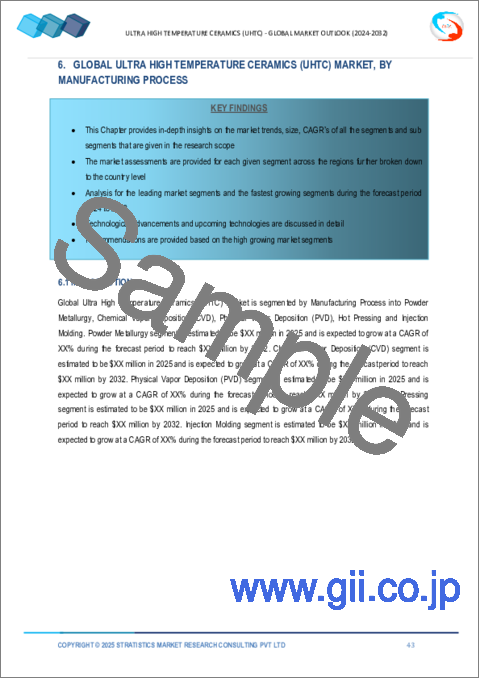|
|
市場調査レポート
商品コード
1558280
超高温セラミックス(UHTC)市場の2030年までの予測: タイプ別、製造プロセス別、形状別、用途別、エンドユーザー別、地域別の世界分析Ultra High Temperature Ceramics Market Forecasts to 2030 - Global Analysis By Type (Tungsten Carbide, Tantalum Carbide, Hafnium Carbide, Zirconium Carbide and Other Types), Manufacturing Process, Form, Application, End User and By Geography |
||||||
カスタマイズ可能
|
|||||||
| 超高温セラミックス(UHTC)市場の2030年までの予測: タイプ別、製造プロセス別、形状別、用途別、エンドユーザー別、地域別の世界分析 |
|
出版日: 2024年09月06日
発行: Stratistics Market Research Consulting
ページ情報: 英文 200+ Pages
納期: 2~3営業日
|
全表示
- 概要
- 図表
- 目次
Stratistics MRCによると、世界の超高温セラミックス(UHTC)市場は予測期間中にCAGR 16.1%で成長しています。
超高温セラミックス(UHTC)は、2000℃(3632°F)を超える極端な温度にも劣化せずに耐えられるように設計された先端セラミック材料の一種です。これらのセラミックスは、炭化ハフニウム(HfC)、炭化タンタル(TaC)、二ホウ化ジルコニウム(ZrB2)などの化合物を含み、卓越した熱安定性、高融点、酸化や熱衝撃への耐性を特徴とします。UHTCは、材料が極限状態に耐えなければならない航空宇宙、原子炉、極超音速飛行などの用途に極めて重要です。
耐高温材料の需要増加
耐高温材料に対する需要の高まりが市場の成長を促進しています。これらの材料は、卓越した熱安定性と極端な温度への耐性を必要とする用途に不可欠です。炭化ハフニウムや二ホウ化ジルコニウムのような化合物を含むUHTCは、2000℃を超える環境で使用されることが多くなっています。産業界が、激しい熱ストレスに耐える、より高度で信頼性の高い材料を求めるようになるにつれ、UHTCは、こうした厳しい性能要件を満たす上で極めて重要な存在になりつつあります。
限られた認識と理解
市場に対する認識と理解が限られていることが、UHTCの普及と市場開拓の妨げとなっています。この知識不足は、UHTCの高温耐性が大きな利点をもたらす可能性のある重要な用途への統合を妨げています。その結果、産業界は、技術的能力を高め、困難な運転環境に効果的に対処する機会を逃し、材料の選択や性能が最適化されない可能性があります。
先端技術への応用
UHTCは、しばしば2000℃を超えるような極端な温度に耐える顕著な能力により、先端技術において重要な役割を果たしています。航空宇宙分野では、宇宙船の熱保護システムに広く利用されており、再突入時の高熱から部品を保護しています。極超音速機では、超高速移動中に発生する高温に耐えるために使用されます。さらに、ロケットノズルや原子炉でも重要な役割を果たしており、熱応力や酸化に対する耐久性や耐性を提供しています。
代替材料との競合
代替材料との競合は、市場に課題を投げかけています。UHTCが高温用途で優れている一方で、耐火金属や先端複合材料のような新興材料は、競争力のある耐熱性と機械的特性を提供しています。このような代替材料は、コスト面で有利になったり、特定の条件下でより優れた性能を発揮したりすることがあります。研究が進めば、新素材が性能向上やコスト削減を実現し、市場シェアに影響を与える可能性があります。
COVID-19の影響:
COVID-19の大流行は、世界のサプライチェーンと製造工程を混乱させ、市場に大きな影響を与えました。規制や操業停止は生産の遅れとコスト増につながり、産業活動の縮小と優先順位の転換はUHTCプロジェクトからリソースを流用しました。さらに、研究開発の延期が技術革新のタイムラインに影響を与えました。こうした課題にもかかわらず、パンデミックは航空宇宙と防衛における先端材料の重要な必要性を浮き彫りにし、産業が回復するにつれてUHTC技術への将来の投資と進歩を加速させる可能性があります。
予測期間中、熱間プレス分野が最大になる見込み
予測期間中、熱間プレスが最大となる見込みです。このプロセスでは、高温と圧力を同時に加えて粉末を高密度の高強度セラミックスに固める。UHTCの熱安定性と機械的特性を高め、過酷な環境に適したものにします。ホットプレスは、航空宇宙と防衛における高度な用途に求められる精密な微細構造と均一性を達成するのに役立ち、UHTC材料の革新と性能向上を促進します。
予測期間中、自動車分野が最も高いCAGRが見込まれる
自動車分野は、予測期間中に最も高いCAGRが見込まれます。UHTCの卓越した熱安定性と高温耐性は、高性能のような高度な自動車部品に理想的です。極端な熱や酸化環境に耐える能力は、エンジンの効率と寿命を向上させる。自動車技術がより高い性能と効率基準に向かって進化するにつれ、UHTCはこうした厳しい要求を満たす上で重要な役割を果たすようになっています。
最大のシェアを占める地域
予測期間中、北米が最大の市場シェアを占めると予測されます。この地域は先端技術と高性能材料に重点を置いているため、宇宙船、極超音速機、ロケットエンジンなどの用途にUHTCの採用が進んでいます。同地域の強力な研究開発インフラは、宇宙開発および防衛技術への多額の投資と相まって、UHTC市場の拡大を支え、同地域を高温材料イノベーションの主要プレーヤーとして位置づけています。
CAGRが最も高い地域:
アジア太平洋地域は、航空宇宙、防衛、エネルギー分野の拡大に牽引され、予測期間中に最も高いCAGRを記録すると予測されます。中国、日本、インドなどの国々は、宇宙探査、極超音速技術、高度な軍事能力に多額の投資を行っており、UHTCの需要増につながっています。これらの国々における急速な工業化と技術の進歩は、高温用途におけるUHTCの採用にさらに拍車をかけています。
無料カスタマイズサービス:
本レポートをご購読のお客様には、以下の無料カスタマイズオプションのいずれかをご利用いただけます:
- 企業プロファイル
- 追加市場プレーヤーの包括的プロファイリング(3社まで)
- 主要企業のSWOT分析(3社まで)
- 地域セグメンテーション
- 顧客の関心に応じた主要国の市場推計・予測・CAGR(注:フィージビリティチェックによる)
- 競合ベンチマーキング
- 製品ポートフォリオ、地理的プレゼンス、戦略的提携に基づく主要企業のベンチマーキング
目次
第1章 エグゼクティブサマリー
第2章 序文
- 概要
- ステークホルダー
- 調査範囲
- 調査手法
- データマイニング
- データ分析
- データ検証
- 調査アプローチ
- 調査情報源
- 1次調査情報源
- 2次調査情報源
- 前提条件
第3章 市場動向分析
- 促進要因
- 抑制要因
- 機会
- 脅威
- 用途分析
- エンドユーザー分析
- 新興市場
- COVID-19の影響
第4章 ポーターのファイブフォース分析
- 供給企業の交渉力
- 買い手の交渉力
- 代替品の脅威
- 新規参入業者の脅威
- 競争企業間の敵対関係
第5章 世界の超高温セラミックス(UHTC)市場:タイプ別
- タングステンカーバイド(WC)
- タンタルカーバイド(TaC)
- ハフニウムカーバイド(HfC)
- 炭化ジルコニウム(ZrC)
- その他のタイプ
第6章 世界の超高温セラミックス(UHTC)市場:製造プロセス別
- 粉末冶金
- 化学蒸着法(CVD)
- 物理蒸着法(PVD)
- ホットプレス
- 射出成形
第7章 世界の超高温セラミックス(UHTC)市場:形態別
- 粉
- セラミック複合材料
- コーティング
- 形状
第8章 世界の超高温セラミックス(UHTC)市場:用途別
- ノズルとスラストチャンバー
- 加熱要素
- 耐火ライニング
- アブレーション材料
- 高速鉄道
- その他の用途
第9章 世界の超高温セラミックス(UHTC)市場:エンドユーザー別
- 航空宇宙および防衛
- 自動車
- エネルギーと電力
- エレクトロニクス
- 産業
- その他のエンドユーザー
第10章 世界の超高温セラミックス(UHTC)市場:地域別
- 北米
- 米国
- カナダ
- メキシコ
- 欧州
- ドイツ
- 英国
- イタリア
- フランス
- スペイン
- その他欧州
- アジア太平洋
- 日本
- 中国
- インド
- オーストラリア
- ニュージーランド
- 韓国
- その他アジア太平洋地域
- 南米
- アルゼンチン
- ブラジル
- チリ
- その他南米
- 中東・アフリカ
- サウジアラビア
- アラブ首長国連邦
- カタール
- 南アフリカ
- その他中東とアフリカ
第11章 主な発展
- 契約、パートナーシップ、コラボレーション、合弁事業
- 買収と合併
- 新製品発売
- 事業拡大
- その他の主要戦略
第12章 企業プロファイリング
- Tosoh Corporation
- 3M
- CeramTec
- Saint-Gobain
- Kyocera Corporation
- Denka Company Limited
- SABIC
- Mitsubishi Materials Corporation
- Precision Ceramics
- Advanced Ceramic Materials
- High Performance Ceramics
- Tungsten Carbide Ceramics Ltd.
- Refractory Metals Corporation
- CeraMaterials LLC
- Morgan Advanced Materials
List of Tables
- Table 1 Global Ultra High Temperature Ceramics (UHTC) Market Outlook, By Region (2022-2030) ($MN)
- Table 2 Global Ultra High Temperature Ceramics (UHTC) Market Outlook, By Type (2022-2030) ($MN)
- Table 3 Global Ultra High Temperature Ceramics (UHTC) Market Outlook, By Tungsten Carbide (WC) (2022-2030) ($MN)
- Table 4 Global Ultra High Temperature Ceramics (UHTC) Market Outlook, By Tantalum Carbide (TaC) (2022-2030) ($MN)
- Table 5 Global Ultra High Temperature Ceramics (UHTC) Market Outlook, By Hafnium Carbide (HfC) (2022-2030) ($MN)
- Table 6 Global Ultra High Temperature Ceramics (UHTC) Market Outlook, By Zirconium Carbide (ZrC) (2022-2030) ($MN)
- Table 7 Global Ultra High Temperature Ceramics (UHTC) Market Outlook, By Other Types (2022-2030) ($MN)
- Table 8 Global Ultra High Temperature Ceramics (UHTC) Market Outlook, By Manufacturing Process (2022-2030) ($MN)
- Table 9 Global Ultra High Temperature Ceramics (UHTC) Market Outlook, By Powder Metallurgy (2022-2030) ($MN)
- Table 10 Global Ultra High Temperature Ceramics (UHTC) Market Outlook, By Chemical Vapor Deposition (CVD) (2022-2030) ($MN)
- Table 11 Global Ultra High Temperature Ceramics (UHTC) Market Outlook, By Physical Vapor Deposition (PVD) (2022-2030) ($MN)
- Table 12 Global Ultra High Temperature Ceramics (UHTC) Market Outlook, By Hot Pressing (2022-2030) ($MN)
- Table 13 Global Ultra High Temperature Ceramics (UHTC) Market Outlook, By Injection Molding (2022-2030) ($MN)
- Table 14 Global Ultra High Temperature Ceramics (UHTC) Market Outlook, By Form (2022-2030) ($MN)
- Table 15 Global Ultra High Temperature Ceramics (UHTC) Market Outlook, By Powder (2022-2030) ($MN)
- Table 16 Global Ultra High Temperature Ceramics (UHTC) Market Outlook, By Ceramic Composites (2022-2030) ($MN)
- Table 17 Global Ultra High Temperature Ceramics (UHTC) Market Outlook, By Coatings (2022-2030) ($MN)
- Table 18 Global Ultra High Temperature Ceramics (UHTC) Market Outlook, By Shapes (2022-2030) ($MN)
- Table 19 Global Ultra High Temperature Ceramics (UHTC) Market Outlook, By Application (2022-2030) ($MN)
- Table 20 Global Ultra High Temperature Ceramics (UHTC) Market Outlook, By Nozzles and Thrust Chambers (2022-2030) ($MN)
- Table 21 Global Ultra High Temperature Ceramics (UHTC) Market Outlook, By Heating Elements (2022-2030) ($MN)
- Table 22 Global Ultra High Temperature Ceramics (UHTC) Market Outlook, By Refractory Linings (2022-2030) ($MN)
- Table 23 Global Ultra High Temperature Ceramics (UHTC) Market Outlook, By Ablative Materials (2022-2030) ($MN)
- Table 24 Global Ultra High Temperature Ceramics (UHTC) Market Outlook, By High-Speed Rail (2022-2030) ($MN)
- Table 25 Global Ultra High Temperature Ceramics (UHTC) Market Outlook, By Other Applications (2022-2030) ($MN)
- Table 26 Global Ultra High Temperature Ceramics (UHTC) Market Outlook, By End User (2022-2030) ($MN)
- Table 27 Global Ultra High Temperature Ceramics (UHTC) Market Outlook, By Aerospace and Defense (2022-2030) ($MN)
- Table 28 Global Ultra High Temperature Ceramics (UHTC) Market Outlook, By Automotive (2022-2030) ($MN)
- Table 29 Global Ultra High Temperature Ceramics (UHTC) Market Outlook, By Energy and Power (2022-2030) ($MN)
- Table 30 Global Ultra High Temperature Ceramics (UHTC) Market Outlook, By Electronics (2022-2030) ($MN)
- Table 31 Global Ultra High Temperature Ceramics (UHTC) Market Outlook, By Industrial (2022-2030) ($MN)
- Table 32 Global Ultra High Temperature Ceramics (UHTC) Market Outlook, By Other End Users (2022-2030) ($MN)
Note: Tables for North America, Europe, APAC, South America, and Middle East & Africa Regions are also represented in the same manner as above.
According to Stratistics MRC, the Global Ultra High Temperature Ceramics (UHTC) Market is growing at a CAGR of 16.1% during the forecast period. Ultra High Temperature Ceramics (UHTCs) are a class of advanced ceramic materials designed to withstand extreme temperatures exceeding 2000°C (3632°F) without degrading. These ceramics, which include compounds such as hafnium carbide (HfC), tantalum carbide (TaC), and zirconium diboride (ZrB2), are characterized by their exceptional thermal stability, high melting points, and resistance to oxidation and thermal shock. UHTCs are crucial for applications in aerospace, nuclear reactors, and hypersonic flight, where materials must endure extreme conditions.
Market Dynamics:
Driver:
Increasing demand for high-temperature resistant materials
The rising demand for high-temperature resistant materials is driving the growth of the market. These materials are essential for applications requiring exceptional thermal stability and resistance to extreme temperatures. UHTCs, including compounds like hafnium carbide and zirconium diboride, are increasingly used in environments that exceed 2000°C. As industries push for more advanced and reliable materials to withstand intense thermal stress, UHTCs are becoming pivotal in meeting these demanding performance requirements.
Restraint:
Limited awareness and understanding
Limited awareness and understanding of the market) can hinder their widespread adoption and development. This lack of knowledge impedes the integration of UHTCs into critical applications where their high-temperature resistance could offer significant benefits. Consequently, industries may miss opportunities to enhance their technological capabilities and address challenging operational environments effectively, leading to suboptimal material choices and performance.
Opportunity:
Applications in advanced technologies
UHTCs play a vital role in advanced technologies due to their remarkable ability to withstand extreme temperatures, often exceeding 2000°C. They are extensively utilized in the aerospace sector for spacecraft thermal protection systems, where they safeguard components from intense re-entry heat. In hypersonic vehicles, they are used to endure the high temperatures generated during ultra-fast travel. Additionally, they are critical in rocket nozzles and nuclear reactors, providing durability and resistance to thermal stress and oxidation.
Threat:
Competition from alternative materials
Competition from alternative materials poses a challenge for the market. While UHTCs excel in high-temperature applications, emerging materials like refractory metals and advanced composites offer competitive thermal resistance and mechanical properties. These alternatives can sometimes provide cost advantages or better performance in specific conditions. As research advances, new materials may offer improved performance or lower costs, potentially impacting market share.
Covid-19 Impact:
The COVID-19 pandemic significantly affected the market by disrupting global supply chains and manufacturing processes. Restrictions and lockdowns led to delays in production and increased costs, while reduced industrial activities and shifting priorities diverted resources from UHTC projects. Additionally, postponed research and development impacted innovation timelines. Despite these challenges, the pandemic highlighted the critical need for advanced materials in aerospace and defense, potentially accelerating future investments and advancements in UHTC technology as industries recover.
The hot pressing segment is expected to be the largest during the forecast period
The hot pressing is expected to be the largest during the forecast period. This process involves applying high temperature and pressure simultaneously to consolidate powders into dense, high-strength ceramics. It enhances the thermal stability and mechanical properties of UHTCs, making them suitable for extreme environments. Hot pressing helps achieve the precise microstructure and uniformity required for advanced applications in aerospace and defense, driving innovation and performance improvements in UHTC materials.
The automotive segment is expected to have the highest CAGR during the forecast period
The automotive segment is expected to have the highest CAGR during the forecast period. UHTCs' exceptional thermal stability and resistance to high temperatures make them ideal for advanced automotive components, such as high-performance. Their ability to withstand extreme heat and oxidative environments can improve engine efficiency and longevity. As automotive technologies evolve towards higher performance and efficiency standards, UHTCs are poised to play a crucial role in meeting these demanding requirements.
Region with largest share:
North America is projected to hold the largest market share during the forecast period. The region's focus on advanced technologies and high-performance materials drives the adoption of UHTCs for applications like spacecraft, hypersonic vehicles, and rocket engines. The region's strong research and development infrastructure, coupled with significant investments in space exploration and defense technologies, supports the expansion of the UHTC market, positioning it as a key player in high-temperature material innovation.
Region with highest CAGR:
Asia Pacific is projected to witness the highest CAGR over the forecast period driven by the region's expanding aerospace, defense, and energy sectors. Countries like China, Japan, and India are investing heavily in space exploration, hypersonic technology, and advanced military capabilities, leading to increased demand for UHTCs. The rapid industrialization and technological advancements in these countries are further fueling the adoption of UHTCs in high-temperature applications.
Key players in the market
Some of the key players in Ultra High Temperature Ceramics (UHTC) market include Tosoh Corporation, 3M, CeramTec, Saint-Gobain, Kyocera Corporation, Denka Company Limited, SABIC, Mitsubishi Materials Corporation, Precision Ceramics, Advanced Ceramic Materials, High Performance Ceramics, Tungsten Carbide Ceramics Ltd., Refractory Metals Corporation, CeraMaterials LLC and Morgan Advanced Materials.
Key Developments:
In February 2024, The Mitsubishi Chemical Group (MCG Group) has announced that it has developed high heat-resistant ceramic matrix composite (CMC) using pitch-based carbon fibers. Providing heat resistance as high as 1,500 °C, the CMC is expected to be used mainly for space industry applications.
In September 2022, SABIC, a global leader in the chemical industry, introduced two new LNP(TM) THERMOCOMP(TM) compounds that offer the potential to improve signal gain performance vs. ceramics in second-generation automotive global navigation satellite system (GNSS) antennas.
Types Covered:
- Tungsten Carbide (WC)
- Tantalum Carbide (TaC)
- Hafnium Carbide (HfC)
- Zirconium Carbide (ZrC)
- Other Types
Manufacturing Process Covered:
- Powder Metallurgy
- Chemical Vapor Deposition (CVD)
- Physical Vapor Deposition (PVD)
- Hot Pressing
- Injection Molding
Forms Covered:
- Powder
- Ceramic Composites
- Coatings
- Shapes
Applications Covered:
- Nozzles and Thrust Chambers
- Heating Elements
- Refractory Linings
- Ablative Materials
- High-Speed Rail
- Other Applications
End Users Covered:
- Aerospace and Defense
- Automotive
- Energy and Power
- Electronics
- Industrial
- Other End Users
Regions Covered:
- North America
- US
- Canada
- Mexico
- Europe
- Germany
- UK
- Italy
- France
- Spain
- Rest of Europe
- Asia Pacific
- Japan
- China
- India
- Australia
- New Zealand
- South Korea
- Rest of Asia Pacific
- South America
- Argentina
- Brazil
- Chile
- Rest of South America
- Middle East & Africa
- Saudi Arabia
- UAE
- Qatar
- South Africa
- Rest of Middle East & Africa
What our report offers:
- Market share assessments for the regional and country-level segments
- Strategic recommendations for the new entrants
- Covers Market data for the years 2022, 2023, 2024, 2026, and 2030
- Market Trends (Drivers, Constraints, Opportunities, Threats, Challenges, Investment Opportunities, and recommendations)
- Strategic recommendations in key business segments based on the market estimations
- Competitive landscaping mapping the key common trends
- Company profiling with detailed strategies, financials, and recent developments
- Supply chain trends mapping the latest technological advancements
Free Customization Offerings:
All the customers of this report will be entitled to receive one of the following free customization options:
- Company Profiling
- Comprehensive profiling of additional market players (up to 3)
- SWOT Analysis of key players (up to 3)
- Regional Segmentation
- Market estimations, Forecasts and CAGR of any prominent country as per the client's interest (Note: Depends on feasibility check)
- Competitive Benchmarking
- Benchmarking of key players based on product portfolio, geographical presence, and strategic alliances
Table of Contents
1 Executive Summary
2 Preface
- 2.1 Abstract
- 2.2 Stake Holders
- 2.3 Research Scope
- 2.4 Research Methodology
- 2.4.1 Data Mining
- 2.4.2 Data Analysis
- 2.4.3 Data Validation
- 2.4.4 Research Approach
- 2.5 Research Sources
- 2.5.1 Primary Research Sources
- 2.5.2 Secondary Research Sources
- 2.5.3 Assumptions
3 Market Trend Analysis
- 3.1 Introduction
- 3.2 Drivers
- 3.3 Restraints
- 3.4 Opportunities
- 3.5 Threats
- 3.6 Application Analysis
- 3.7 End User Analysis
- 3.8 Emerging Markets
- 3.9 Impact of Covid-19
4 Porters Five Force Analysis
- 4.1 Bargaining power of suppliers
- 4.2 Bargaining power of buyers
- 4.3 Threat of substitutes
- 4.4 Threat of new entrants
- 4.5 Competitive rivalry
5 Global Ultra High Temperature Ceramics (UHTC) Market, By Type
- 5.1 Introduction
- 5.2 Tungsten Carbide (WC)
- 5.3 Tantalum Carbide (TaC)
- 5.4 Hafnium Carbide (HfC)
- 5.5 Zirconium Carbide (ZrC)
- 5.6 Other Types
6 Global Ultra High Temperature Ceramics (UHTC) Market, By Manufacturing Process
- 6.1 Introduction
- 6.2 Powder Metallurgy
- 6.3 Chemical Vapor Deposition (CVD)
- 6.4 Physical Vapor Deposition (PVD)
- 6.5 Hot Pressing
- 6.6 Injection Molding
7 Global Ultra High Temperature Ceramics (UHTC) Market, By Form
- 7.1 Introduction
- 7.2 Powder
- 7.3 Ceramic Composites
- 7.4 Coatings
- 7.5 Shapes
8 Global Ultra High Temperature Ceramics (UHTC) Market, By Application
- 8.1 Introduction
- 8.2 Nozzles and Thrust Chambers
- 8.3 Heating Elements
- 8.4 Refractory Linings
- 8.5 Ablative Materials
- 8.6 High-Speed Rail
- 8.7 Other Applications
9 Global Ultra High Temperature Ceramics (UHTC) Market, By End User
- 9.1 Introduction
- 9.2 Aerospace and Defense
- 9.3 Automotive
- 9.4 Energy and Power
- 9.5 Electronics
- 9.6 Industrial
- 9.7 Other End Users
10 Global Ultra High Temperature Ceramics (UHTC) Market, By Geography
- 10.1 Introduction
- 10.2 North America
- 10.2.1 US
- 10.2.2 Canada
- 10.2.3 Mexico
- 10.3 Europe
- 10.3.1 Germany
- 10.3.2 UK
- 10.3.3 Italy
- 10.3.4 France
- 10.3.5 Spain
- 10.3.6 Rest of Europe
- 10.4 Asia Pacific
- 10.4.1 Japan
- 10.4.2 China
- 10.4.3 India
- 10.4.4 Australia
- 10.4.5 New Zealand
- 10.4.6 South Korea
- 10.4.7 Rest of Asia Pacific
- 10.5 South America
- 10.5.1 Argentina
- 10.5.2 Brazil
- 10.5.3 Chile
- 10.5.4 Rest of South America
- 10.6 Middle East & Africa
- 10.6.1 Saudi Arabia
- 10.6.2 UAE
- 10.6.3 Qatar
- 10.6.4 South Africa
- 10.6.5 Rest of Middle East & Africa
11 Key Developments
- 11.1 Agreements, Partnerships, Collaborations and Joint Ventures
- 11.2 Acquisitions & Mergers
- 11.3 New Product Launch
- 11.4 Expansions
- 11.5 Other Key Strategies
12 Company Profiling
- 12.1 Tosoh Corporation
- 12.2 3M
- 12.3 CeramTec
- 12.4 Saint-Gobain
- 12.5 Kyocera Corporation
- 12.6 Denka Company Limited
- 12.7 SABIC
- 12.8 Mitsubishi Materials Corporation
- 12.9 Precision Ceramics
- 12.10 Advanced Ceramic Materials
- 12.11 High Performance Ceramics
- 12.12 Tungsten Carbide Ceramics Ltd.
- 12.13 Refractory Metals Corporation
- 12.14 CeraMaterials LLC
- 12.15 Morgan Advanced Materials






